Holmenkollen is a true Norwegian icon, blending history, adventure, and spectacular scenery. Beyond its famous ski jump, this year-round destination invites exploration of Oslo’s outdoor culture, whatever the season.
Perched high above Oslo, the iconic Holmenkollen ski jump dominates the city’s skyline, a striking symbol of Norway’s deep connection to winter sports.
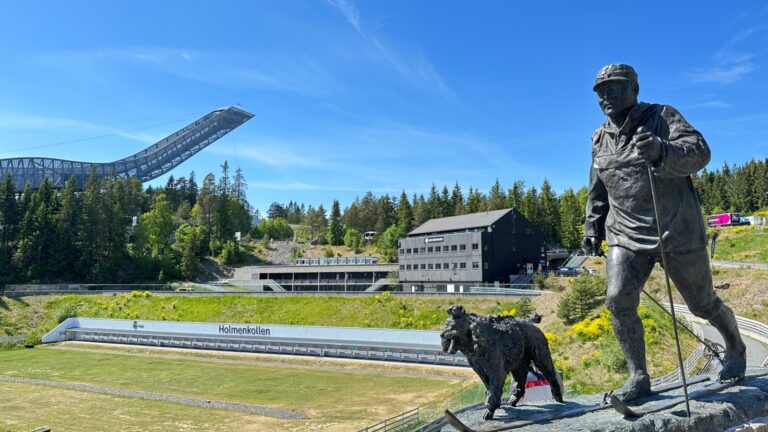
As one of Norway’s most famous landmarks, Holmenkollen is a must-see attraction for visitors to the Norwegian capital. But there’s much more to this arena than the ski jump alone.
From panoramic views over the Oslofjord to a fascinating ski museum and thrilling activities, Holmenkollen offers something for everyone, no matter the season.
Whether you’re visiting in the crisp winter months or the sun-drenched days of summer, Holmenkollen promises a memorable experience that captures the essence of Norway’s outdoor spirit.
A World-Class Winter Sports Arena
Holmenkollen is synonymous with winter sports in Norway, and for good reason. As one of the world’s most famous ski arenas, it has a rich history that dates back to its first ski jump competition in 1892.
Today, Holmenkollen is a state-of-the-art facility that hosts prestigious international events, including World Cup ski jumping, Nordic skiing, and biathlon competitions.
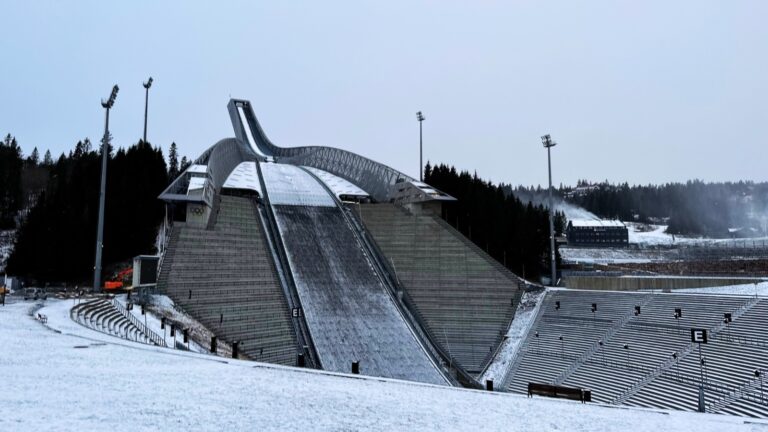
Its iconic ski jump, totally redesigned in 2010, is a marvel of modern engineering, rising 64 metres above the ground and offering stunning views of Oslo and the fjord below.
For spectators, there’s nothing quite like the electrifying atmosphere of a winter sports event at Holmenkollen. Thousands of fans gather to cheer on athletes as they soar through the air or race through challenging Nordic trails.
The Holmenkollen Ski Festival, held annually, is a particular highlight, bringing together top-tier competitors and enthusiastic crowds in a celebration of Norway’s winter traditions.
Holmenkollen isn’t just for professional athletes. The surrounding area offers opportunities for visitors to try cross-country skiing on beautifully groomed trails or tobogganing on family-friendly slopes.
Whether you’re a passionate winter sports fan or just curious about Norway’s skiing culture, Holmenkollen delivers an unforgettable experience that highlights why Norway is known as the birthplace of modern skiing.
Holmenkollen in the Winter
Visiting in the winter is well worth it, regardless of whether there’s an event taking place. In fact, it’s worth checking that first (on the Holmenkollen website), as your experience will be markedly different if there is a major competition on.
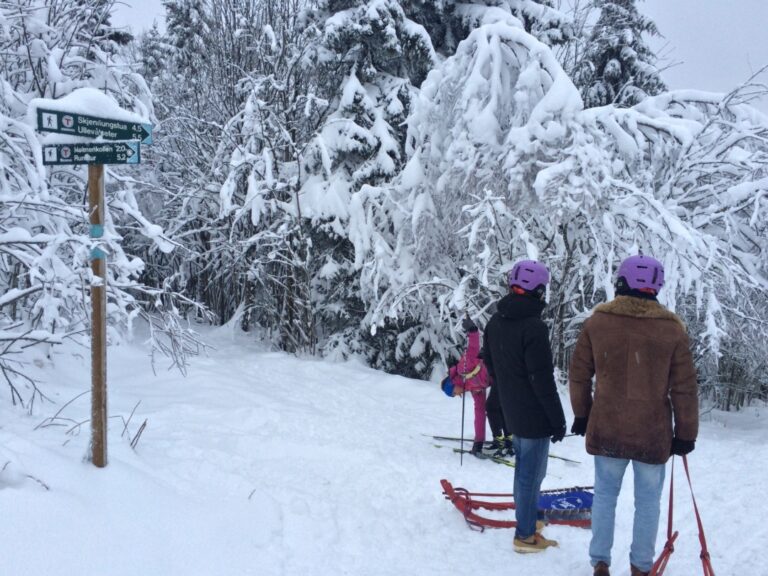
If there’s not, visit the ski museum and stroll around the arena to imagine what it’s like during a major event. Remember, there can be snow up here even when there’s none in the city centre, so wear sensible footwear.
In the winter, watch out for cross-country skiers using the marked tracks around the area. Pay attention to signage, and do not walk on these areas! Both keen amateurs and professionals use these trails for training.
Holmenkollen in the Summer
Although going to a ski arena in the summer may not be your first thought, it’s actually a very fun time to pay Holmenkollen a visit.
The view from the top of the ski tower across Oslo and the fjord is unbeatable. Is it worth the steep price to use the tower elevator? That’s your call. You’ll also be sharing the elevator with those planning to use the zip line.
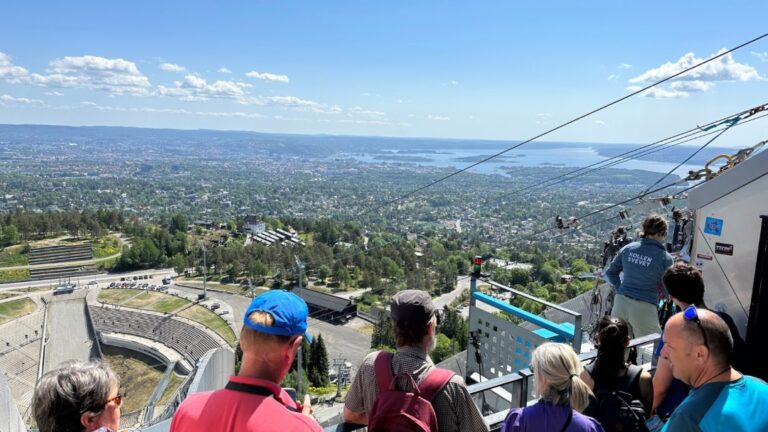
Yes, zip line! In recent years, Holmenkollen has played host to a thrilling zip line from the top of the zip line to the base of the ski jump, providing you with a unique perspective on Oslo—if you can keep your eyes open, of course!
The forested area around Holmenkollen is also ideal for summer exploration. You’ll bump into locals out for walks, picnics, or even playing a round of frisbee golf.
Holmenkollen Ski Museum
To celebrate its centenerary, Holmenkollen Ski Museum has recently been completely overhauled. Built into the ski jump and the mountainside, the ski museum is a lot bigger than you first expect.
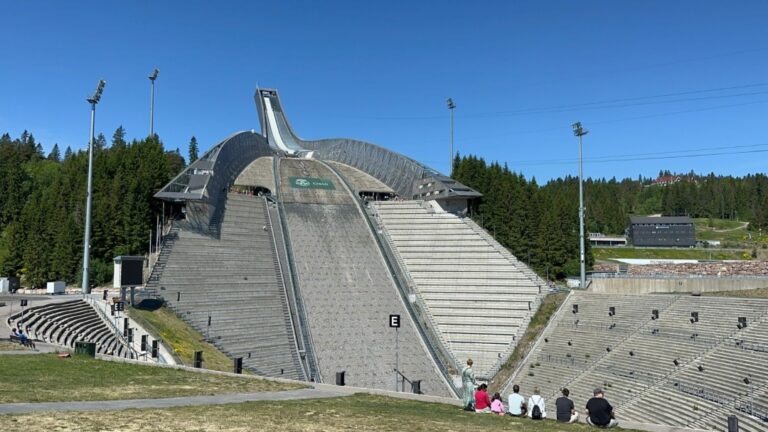
Discover thousands of years of ski history, from the oldest skis to have ever been found in Norway to the history of polar exploration, in which skis played a vital role, of course.
Holmenkollen Chapel
A short walk away from the area, Holmenkollen Chapel is worth a closer look. Although appearing a historic structure from a distance, the chapel was actually rebuilt and opened in 1996 following an arson attack four years earlier.
The original version was built in 1903 as a chapel to allow hikers to attend a service while still enjoying their favourite pasttime on a Sunday. A few years later, the Royal Lodge was built nearby, still a regular favourite of the Royals to this day.
The new chapel, inspired by the stave churches of Rauland and Heidal, is built using traditional techniques with massive planks, pine walls, and solid spruce root arches. A precise 3D model was created to aid construction, with components crafted in Vågå.
Featuring stave church elements and dragestil wood carvings, the chapel functions as a working church and includes an assembly hall, kitchen, and meeting rooms.
How to Get to Holmenkollen
Given the cost of driving and parking in Norway’s capital city, public transport in Oslo is the best way to get to the ski arena.
Line 1 of the Oslo Metro (T-Bane) in the direction of Frognerseterbanen takes you to Holmenkollen station. From here, it’s about a 10-minute walk, but be warned, it’s quite steep.
Also be aware the T-Bane system is under extensive changes through the city centre in 2025, so check the route maps before you travel.
Have you been to Holmenkollen recently? I’d love to hear what you think of the arena, especially if you’ve been to the renovated museum or used the zip line! Just let me know down in the comments.

